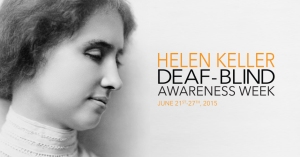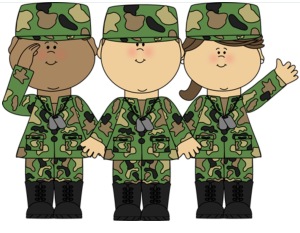Helen Keller Deaf-Blind Awareness Week
22 Jun 2016 Leave a comment
in Awareness, Chicken, daily prompt, Family, mothers, My Thoughts, mystery, this day in history, Thought for the Day., Uncategorized Tags: Awareness, children, Health Awareness, Thoughts
Helen Keller Deaf-Blind Awareness Week
Thirty years ago this month, President Ronald Reagan issued a presidential proclamation designating the last week of June as “Helen Keller Deaf-Blind Awareness Week.” Every year since, the Helen Keller National Center for Deaf-Blind Youths & Adults (HKNC) commemorates the week with a national advocacy campaign in recognition of the achievements and capabilities of people who are deaf-blind.
In 2014, Helen Keller Deaf-Blind Awareness Week is June 22 to June 28. This year’s theme, “SHE’S DEAF-BLIND AND, WITH TECHNOLOGY, SHE HOLDS THE WORLD IN HER HANDS…JUST LIKE HER LOVED ONES,” highlights the fact that, through technology, people who are deaf-blind can now access the world around them independently.
In an increasingly digital world, HKNC is working with deaf-blind individuals to stay connected to their friends, family, and peers through the National Deaf-Blind Equipment Distribution Program. This program ensures that qualified individuals with a combined hearing and vision loss can obtain accessible telecommunications devices at no cost and the necessary training to use them.

“Few things can brighten my whole day as quickly as the smile of a baby giraffe…”
22 Jun 2016 Leave a comment
in children, daily prompt, Family, fun facts, My Thoughts, pets, Photo Challenge, photo of the day, Thought for the Day., Uncategorized Tags: animals
History of Fathers Day
19 Jun 2016 Leave a comment
in Awareness, children, daily prompt, mothers, My Thoughts, thought of the day, today in history Tags: Awareness, Family, fun facts, Thoughts
History of Father’s Day
It would be interesting to know how Father’s Day came into practice and celebrated worldwide with an equal sincerity and respect as any other significant holidays. Here’s a short history on the holiday, and meaning of the different colors of roses to be worn that Day. Get to know what are the truest reasons associated for the celebration of this special celebration. You may even refer the page to others to share the information by clicking on the link given below.

There are many theories associated with the observance of Father’s Day; the two theories which are quite known prevalent for the celebration of the first Father’s Day celebration in the United States are as stated. The first theory to regarding the celebration of Father’s Day was established on June 19, 1908 in the State of Washington when an independent celebration of Father’s Day, a few weeks later, took place on 5th July, 1908 in Fairmont, West Virginia.
Hence the first Father’s Day was recognized in West Virginia, while a church service was going on at Williams Memorial Methodist Episcopal Church South. Grace Golden Clayton, who reportedly suggested the service to the pastor at Williams Memorial, is said to have been inspired to celebrate fathers post a mine explosion, a few months before, in the nearby community of Monongah. This explosion ended 361 lives, many of them fathers and recent immigrants to the States from Italy.
Another influencing force which further reinforced the establishment of Father’s Day was that of Mrs. Sonora Smart Dodd. Dodd thought of the idea for Father’s Day while listening to a Mother’s Day sermon in 1909. Having been raised by her father, Henry Jackson Smart, after her mother died, Sonora wanted her father to know how special he was to her. It was her father that made all the parental sacrifices and was, in the eyes of his daughter, a courageous, selfless, and loving man. Hence, since Sonora’s father was born in June, so she chose to hold the first Father’s Day celebration in Spokane in June. Although she initially thought of celebrating Father’s Day on June 5 in Spokane (which was her father’s birthday), the other people involved did not agree they would have enough time for an appropriate celebration. Thus, the first Father’s Day was held instead on the third Sunday in the month of June. The first June Father’s Day was celebrated on 19th June, 1908, in Spokane, WA, at the Spokane YMCA. Politician and orator, William Jennings Bryan appreciated the concept immediately and began extending his support widely. Father’s Day was then initiated by President Woodrow Wilson, who was the first U.S. President to celebrate it on June 1916, a party his family hosted. President Calvin Coolidge declared it a national holiday in 1924. In 1966, President Lyndon Johnson, by official order, made Father’s Day a holiday to be celebrated on the third Sunday of June. The holiday was not formally considered until 1972, when it was officially acknowledged by a Congressional Act setting it permanently on the third Sunday in June all over the nation.
Read more at http://www.theholidayspot.com/fathersday/history.htm#5op01LxmHUmOe4Tt.99
Weekly Photo Challenge – Curve
17 Jun 2016 Leave a comment
in daily prompt, fun facts, landscape, My Thoughts, Photo Challenge, photo of the day, picture of the week, weekly photo challenge Tags: Awareness, photo, photos, picture, Weekly Photo Challenge
For additional submissions to this challenge go to Curve
Celebrate National Men’s Health Week, June 13-19, 2016.
13 Jun 2016 Leave a comment
in Chicken, daily prompt, Family, Love, mystery, this day in history, Thought for the Day., Uncategorized Tags: Awareness, Family, fun facts, Health Awareness
Get Good Sleep
Adults need between 7-9 hours of sleep. Insufficient sleep is associated with a number of chronic diseases and conditions, such as diabetes, cardiovascular disease, obesity, and depression. Also, poor sleep is responsible for motor vehicle and machinery-related accidents.
Toss out the Tobacco
It’s never too late to quit(https://www.cdc.gov/tobacco/quit_smoking/index.htm). Quitting smoking has immediate and long-term benefits. It improves your health and lowers your risk of heart disease, cancer, lung disease, and other smoking-related illnesses.
Also avoid secondhand smoke(https://www.cdc.gov/tobacco/basic_information/secondhand_smoke/index.htm). Inhaling other people’s smoke causes health problems similar to those that smokers have. Babies and kids are still growing, so the poisons in secondhand smoke hurt them more than adults.
- Smokefree.gov
- Protecting Our Children from Secondhand Smoke(https://www.cdc.gov/tobacco/basic_information/secondhand_smoke/protect_children/index.htm)
- Tips from Former Smokers(https://www.cdc.gov/tobacco/campaign/tips)
Move More
Adults need at least 2½ hours(https://www.cdc.gov/physicalactivity/everyone/guidelines/adults.html) of moderate-intensity aerobic activity every week, and muscle strengthening activities that work all major muscle groups (legs, hips, back, abdomen, chest, shoulders, and arms) on two or more days a week. You don’t have to do it all at once. Spread your activity out during the week, and break it into smaller amounts of time during the day.
- Physical Activity for Everyone(https://www.cdc.gov/physicalactivity/everyone/guidelines/adults.html)
- Physical Activity and Disability(https://www.cdc.gov/features/physical-activity-disabilities/index.html)
Eat Healthy
Eat a variety of fruits and vegetables every day. Fruits and vegetables have many vitamins and minerals that may help protect you from chronic diseases. Limit foods and drinks high in calories, sugar, salt, fat, and alcohol.
- Nutrition for Everyone(https://www.cdc.gov/nutrition/everyone/index.html)
- Fruits and Vegetables(https://www.cdc.gov/nutrition/everyone/fruitsvegetables/index.html)
- Eat Less Salt – What You Can Do(https://www.cdc.gov/salt/what_you_can_do.htm)
Tame Stress
Sometimes stress can be good. However, it can be harmful when it is severe enough to make you feel overwhelmed and out of control. Take care of yourself. Avoid drugs and alcohol. Find support. Connect socially. Stay active.
- Managing Stress(https://www.cdc.gov/Features/HandlingStress)
- Excessive Alcohol Use and Risks to Men’s Health(https://www.cdc.gov/alcohol/fact-sheets/mens-health.htm)
Stay on Top of Your Game
See your doctor or nurse for checkups. Certain diseases and conditions may not have symptoms, so checkups help identify issues early or before they can become a problem.
Pay attention to signs and symptoms such as chest pain, shortness of breath, excessive thirst, and problems with urination. If you have these or symptoms of any kind, be sure to see your doctor or nurse. Don’t wait!
- Cancer and Men(https://www.cdc.gov/features/cancerandmen/index.html)
- HIV/AIDS and Sexually Transmitted Diseases(https://www.cdc.gov/std/hiv/default.htm)
- Heart Disease Signs and Symptoms(https://www.cdc.gov/heartdisease/signs_symptoms.htm)
Keep track of your numbers for blood pressure, blood glucose, cholesterol, body mass index (BMI), or any others you may have. If your numbers are high or low, your doctor or nurse can explain what they mean and suggest how you can get them to a healthier range. Be sure to ask him or her what tests you need and how often you need them.
- High Blood Pressure(https://www.cdc.gov/bloodpressure/diastolic_systolic.htm)
- Checking Your Blood Glucose
- Cholesterol(https://www.cdc.gov/cholesterol/index.htm)
- BMI(https://www.cdc.gov/healthyweight/assessing/bmi)
Get vaccinated. Everyone needs immunizations to stay healthy, no matter how old you are. Even if you had vaccines as a child, immunity can fade with time. Vaccine recommendations are based on a variety of factors, including age, overall health, and your medical history.
Men’s Health
11 Jun 2016 2 Comments
in Awareness, children, daily prompt, Family, My Thoughts, today in history, Uncategorized Tags: Awareness, children, Family, Health Awareness
What You Don’t Know May Hurt You
Most men know by now that good lifestyle choices – such as exercising regularly, eating a healthy diet, not smoking and drinking in moderation – make a big difference in staying healthy. Men may too often ignore these sensible recommendations, but it’s not because they’re not aware of them.
What many don’t realize is that environmental exposures also contribute to major diseases and health concerns that primarily affect men. EWG’s researchers scoured the scientific literature and uncovered troubling data that may come as a surprise. There has been significant research in recent decades showing that chronic conditions such as heart disease, prostate cancer, infertility may be linked to everyday exposures to chemicals in water, consumer products and food.
Additionally, many men don’t know that they’re at a higher risk than women of developing skin cancer and dying from its most fatal form, melanoma. Read EWG’s advice on some of the alarming trends regarding skin cancer, and why men should engage in proper sun safety.
There’s not much you can do about your genetics, but there are lots of ways to reduce exposures to potentially harmful chemicals and other environmental risk factors, so why not follow some of EWG’s tips and increase your chances of living the healthiest and longest life possible?
















